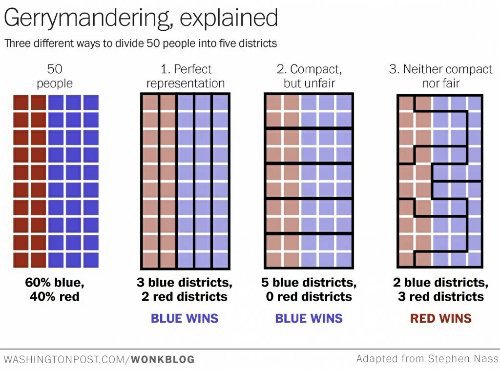| |
|---|---|
Gerrymandering and the Electoral College
"The Electoral College is not "The Will of the People"
Primary Elections: Should ballots be
multiparty?
Primary party ballots are for choosing who will represent the party, like choosing your champion. A multiparty ballot would allow voting against other party champions at the same time. In open primary states, you get to choose which party you want to help (or hurt) but you can't do both at the same time. Each party fields only one candidate for each office so as not to split the vote. The problem is that a split vote practically guarantees losing to a single opposition candidate. For example, when the left is split by a third party; the right wins.
Parliamentarians with multiple parties have to form a coalition majority in order to establish a new government, leaving the rest as the opposition. This is to insure the ruling coalition represents a majority of the people. The coalition "party" then chooses the officers.
The Electoral College
The United States is more than a country of people. It is a union of individual sovereign states that delegated some authority to a federation, but kept the remaining authority to themselves and to the people.
The Tenth Amendment
The powers not delegated to the United States by the constitution, nor prohibited by it to the States, are reserved to the States respectively, or to the people."
Each state has it's own Constitution and laws.
We choose the top of the ticked by a vote of the states, not by a vote of the parties. The electoral college chooses the POTUS and VPOTUS by state votes which comprises a combination of 2 votes per state and by the number of votes proportional to the population of the people. The population votes per state are cast as the state legislature decides, usually all rather than split.
In 1913 the 17th Amendment changed the election of senators from the state legislatures to the popular vote of the people - one step closer to a true representational republic. This progress is incomplete and is marred by the Electoral College, which can permit a minority to dominate the process, leaving the country run not by the majority, but by a minority. Such is the case with the Election of Donald Trump.
The electoral college is the way the founding fathers
balanced states rights with the people's rights for choosing the top
two leaders and the ruling plurality. The Senate represents the
states. The house represents the people, state by state. Each state
has two Senators to represent the rights of the state. Each state has
representatives in proportion to it's population to represent the
people, with a minimum of one such representative.
The President and Vice president aren't appointed by the
people, they are appointed by the Electoral College. But each state
retained the right to choose how they would cast their own electoral
college votes. Most continue to use the all or none rule rather than
vote proportionally.
In principle, the House makes laws for the people. Then the Senate tweaks them for the states. Then they compromise, allegedly balancing the rights of the people with States' rights.
With the electoral college, the House makes laws for the plurality of the last election. In states with split party senators, the state's Senate representation tends to be canceled out on party lines, leaving the plurality to represent the loudest voices, those who pay for the cost of running for office, now-a-days the corporations and richest donors. The founding fathers never anticipated the effect of the media, the gerrymandering of state districts by the plurality party in order to keep themselves in power, nor the influence of money.
 Gerrymandering increases the disparity between the plurality and
the proportion of the population. With gerrymandering, a
significantly smaller plurality can facilitate a party getting and
remain control of a state legislatures and consequently the House.
That's why the party in power redistricts after each census.
Gerrymandering increases the disparity between the plurality and
the proportion of the population. With gerrymandering, a
significantly smaller plurality can facilitate a party getting and
remain control of a state legislatures and consequently the House.
That's why the party in power redistricts after each census.
Gerrymandering is fencing in as many who would likely vote against
the party in power as possible so that the voters do not vote against
the party in power in other districts. That replaces opposition votes
with supporting votes in the other districts, so that there are more
districts with fewer opposition voters and fewer districts with
opposition voters.
That
gives the gerrymandering party control of the state legislature and
thereby the power to control the electoral college votes of the
state. This Washington Post illustration shows how it's done.
We can get rid of the influence of gerrymandering on federal
elections by a simple change to the constitution without otherwise
revising electoral college. Here is a proposed amendment to make the electoral college proportional.